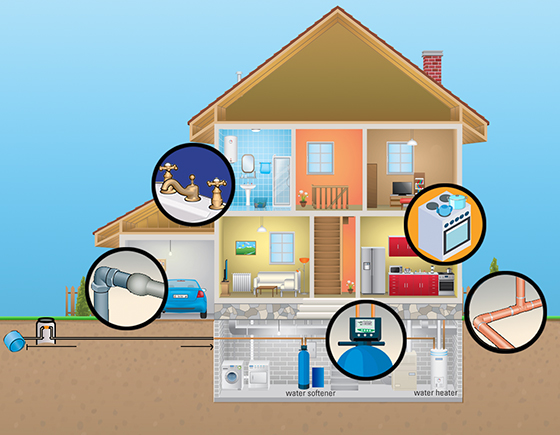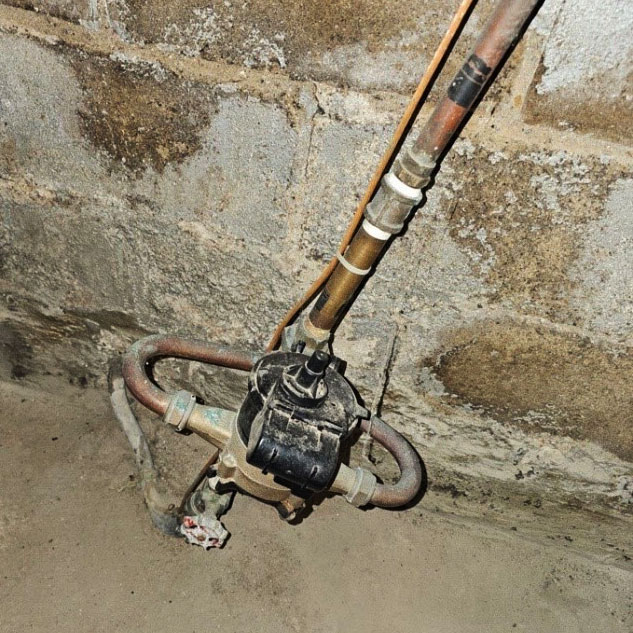Minimize Your Exposure to Lead
Worried about lead in your drinking water?
Homes built before 1988 might contain lead in their plumbing systems, which can affect water safety. While the water Aquarion provides does not contain lead, it's important to be aware of potential lead sources within your service line and your home's plumbing.
Here, you'll find useful tips for finding potential lead sources and what steps to take if you suspect lead in your home.

Common sources of lead in your home
Depending on the age of your home, it may have lead lines, pipes, fittings, and/or fixtures. For example:
- Homes built in the mid-1950s may have galvanized iron or steel plumbing lines (galvanized pipes can corrode and trap lead).
- Homes built before 1988 may have lead service lines. With a few exceptions, most were installed in homes built before 1930.
- Homes built before 1988 may have plumbing with lead solder and/or brass components that may have lead.
- Water faucets and fixtures labelled “lead free,” but installed before 2014, may still have (low) levels of lead.

How Aquarion protects your water from lead
Aquarion tests your water for more than one hundred compounds, including ones that may increase the corrosion of metals, including lead, in your service line or in your home plumbing.
Where necessary we carefully adjust pH levels and introduce compounds designed to minimize corrosion. These compounds coat the pipes and fixtures in your home to reduce the risk of lead leaching into your water. While corrosion control helps to reduce the amount of lead that may leach from lead materials in your plumbing system, these steps may not be 100% effective in all cases.
Aquarion performs compliance testing in accordance with regulations established by the Environmental Protection Agency (EPA) and applicable State agencies to ensure we protect the public health of the communities we serve. However, if you have questions about your home, we recommend you have an independent testing lab check the water from your taps to see if lead is present.
For more information, call the EPA Safe Drinking Water Hotline at 1 (800) 426-4791 or contact Aquarion's Water Quality Management Department.
How to find lead in and around your home’s plumbing system
Extensive testing shows that Aquarion's treatment is effective and keeps your water safe. So, if there's lead in your water, it usually comes from the plumbing inside your home. Follow these steps to check if your home's plumbing has lead:
- Hire a licensed plumber to inspect your service line and home's plumbing system, and have them replace lead sources wherever possible.
- Purchase a lead solder test kit at hardware and home supply stores and follow the kit's instructions to test for lead in your plumbing.

Learn about lead service line replacement
Are you planning to have your lead service line replaced?
If the portion of the service line that you own is lead, you should consider having a local plumber replace it for you. To let us know that you are having your lead service line replaced, contact us. Once contacted, we will provide you with flushing instructions, a pitcher filter, and an offer of follow-up sampling to minimize your exposure to lead following your replacement.
Have questions about our lead service line replacement programs?
View your state below to learn about lead service line replacement programs in your state of residence:
- Connecticut and New Hampshire: Aquarion is working towards identifying financing programs to assist homeowners with service line replacements. We are also in the process of developing a replacement program which may include assistance and financing options in the coming years. Aquarion has applied for state funding to support the replacement program which may determine the types of financial assistance that will become available. For more information, contact us or visit the following resources:
- Connecticut Department of Public Health - Childhood Lead Poisoning Prevention Program
- New Hampshire Department of Environmental Services - Lead in Drinking Water
- Massachusetts: Aquarion has developed a lead service line replacement plan for each of its water systems in Massachusetts. This plan includes funding opportunities and procedures for lead service line replacement. For more information, or to request a copy of the lead service line replacement plan, contact us or visit Mass.gov - Lead in Drinking Water.
Not sure if your service line is lead?
Visit our Service Line Inventory to search for your address and find out the material of your service line.
Steps you can take to reduce your exposure to lead in drinking water
Until you can identify and replace sources of lead, or if it is not practical to replace sources of lead, take the following steps:
- Always use cold water for drinking, cooking, and preparing baby formula. Never ingest hot water from the tap.
- Do not rely on your senses, because lead dissolved in water cannot be seen, tasted, or smelled. Remember: boiling water does not remove lead.
- If you have a lead service line, run your faucet for 3–5 minutes anytime that you have not used water in your home for several hours. Often this is first thing in the morning and again in the evening. This removes lead that may leach from your plumbing. This is especially important if you have been away from home for several days or weeks.
- Periodically remove and clean the screens/aerators on your faucets. Run the water while the screens/aerators are removed to eliminate any debris.
- Hire a licensed electrician to check your wiring. Your home's electrical system may be attached to your service line or elsewhere in your plumbing. If this connection is electrified, it can accelerate corrosion. DO NOT attempt to change the wiring yourself! Improper grounding can cause electrical shock and fire hazards.
Run your faucets daily
The chance of lead leaching into your water is greater when the water has been standing in your home's pipes for several hours. Running your faucet will bring in new, cool water from the water main. This removes lead that may leach from your plumbing. This is especially important if you have been away from home for several days or weeks.
Before using a faucet for drinking, cooking, or preparing baby formula, all customers should run the cold water for 30 seconds to 1 minute or until it feels as cold as it can be.
If your home has lead service or plumbing lines, brass fittings, lead solder, or older faucets containing lead, run the water for 3-5 minutes anytime that you haven’t used water in your home for several hours. This is often first thing in the morning and again in the evening.
To support conservation efforts, consider capturing this water and using it for laundry, cleaning, watering your plants and lawn, and washing your car. Do not drink it or use it for cooking.
What to do after plumbing work
Maintenance work on lead service lines or on your home's plumbing may release lead particles into your water, which could impact your health. Therefore, it is very important to do a 30-minute “flush” to remove any lead particles that may be in your home plumbing lines:
- Remove the faucet aerators from all cold-water taps and clean them.
- Beginning in the lowest level of your home, fully open all cold water taps in sinks, tubs, and showers. Make sure the drains are open and clear.
- Run the cold water for at least 30 minutes at the last tap opened (top floor).
- Turn off taps, starting with the first faucet you opened, usually in the basement.
- If desired, capture the flushed water and use it for laundry, cleaning, washing your car, watering your plants and lawn, or other household uses. Do not drink it or use it for cooking.
- Repeat this 30-minute flush every other week for a period of 3 months.
- For a period of 6 months, run the cold water daily for 3-5 minutes before using a faucet for drinking, cooking, or preparing baby formula.
- After 6 months, continue to run your faucets daily according to the previous section.
Remember:
- Use only cold water for cooking.
- Boiling water does not remove lead!
Install in-home water filters
If you or your plumber discover galvanized iron or lead in your service line and/or your home's plumbing, you may wish to use an in-home water filter.
The National Sanitation Foundation (NSF), a public health and safety organization, has tested and compiled an extensive list of devices certified to filter for lead. The products include pour-through water pitchers, faucet-mounted filters, and whole-home filters. Review their list of in-home water filter recommendations. If you choose to use a filter in your home, please make sure to follow the manufacturer’s instructions, including for filter replacement.
How to test your water for lead
Explore the links below for a list of laboratories certified to test for lead in drinking water:
Learn About Lead
Discover the health risks of lead in drinking water and Aquarion's measures to help address lead in water systems.
Learn More